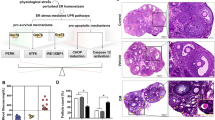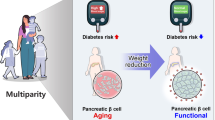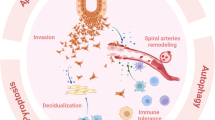Abstract
Although perinatal mortality rates have improved for pregnant diabetic women because of insulin therapy and tight metabolic control, infants of diabetics still experience significantly higher rates of congenital malformations and spontaneous miscarriages compared with those of non-diabetic women 1 . Our results here indicate that hyperglycemic conditions, either in vivo or in vitro , modulate the expression of an apoptosis regulatory gene as early as the pre-implantation blastocyst stage in the mouse. Apoptosis in the mammalian pre-implantation blastocyst is a normal process, thought to protect the early embryo by eliminating abnormal cells 2 . Here we demonstrate that expression of Bax, a Bcl-2-like protein, is increased at the blastocyst stage in the presence of high concentrations of glucose, and that these changes correlate morphologically with increased DNA fragmentation. Expression of Bax and caspase are necessary for this in vitro glucose-induced apoptotic event, and ceramide is involved in mediating this embryotoxic effect of glucose. We also show that these apoptotic cellular changes can be prevented in vivo by treating hyperglycemic mice with insulin before and immediately after conception. These findings emphasize the importance of tight glycemic control in diabetic women at the earliest stages after conception.
This is a preview of subscription content, access via your institution
Access options
Subscribe to this journal
Receive 12 print issues and online access
$209.00 per year
only $17.42 per issue
Buy this article
- Purchase on Springer Link
- Instant access to full article PDF
Prices may be subject to local taxes which are calculated during checkout



Similar content being viewed by others
References
Miller, E. et al. Elevated maternal hemoglobin A1C in early pregnancy and major congenital anomalies in infants of diabetic mothers. N. Engl. J. Med. 304, 1331–1334 (1981).
Pierce, G.B., Lewellyn, A.L. & Parchment, R.E. Mechanism of PCD in the blastocyst. Proc. Natl. Acad. Sci. USA 86, 3654–3658 (1989).
Moley, K.H., Vaughn, W.K., DeCherney, A.H. & Diamond, M.P. Effect of diabetes mellitus on mouse pre-implantation embryo development. J. Reprod. Fertil. 93, 325– 332 (1991).
Lea, R.G., McCraken, J.E., McIntyre, S.S., Smith, W. & Baird, J.D. Disturbed development of the preimplantation embryo in the insulin-dependent diabetic BB/E rat. Diabetes 45, 1463–1470 (1996).
Pampfer, S., Vanderheyden, I., McCracken, J.E., Vesala, J. & DeHertogh, R. Increased cell death in rat blastocysts exposed to maternal diabetes in utero and to high glucose or tumor necrosis factor alpha in vitro. Development 124, 4827–4836 (1997).
Moley, K.H., Chi, M.M-Y. & Mueckler, M.M. Maternal hyperglycemia alters glucose transport and utilization in mouse preimplantation embryos. Am. J. Physiol. 275, E38–E47 (1998).
Knudson, C.M., Tung, K.D.K., Tourtellote, W.G., Brown, C.A.J. & Korsmeyer, S.J. Bax-deficient mice with lymphoid hyperplasia and male germ cell death. Science 270, 96–99 (1995).
Jacobson, M.D., Weil, M. & Raff, M.C. Role of Ced-3/ICE-family proteases in staurosporine-induced programmed cell death. J. Cell. Biol. 133, 1041–1051 (1996).
Xiang, J., Chao, D.T. & Korsmeyer, S. J. BAX-induced cell death may not require interleukin-1B-converting enzyme-like proteases. Proc. Natl. Acad. Sci. USA 93, 14559–14563 (1996).
Chinnaiyan, A.M. et al. Molecular ordering of the cell death pathway. Bcl-2 and Bcl-xL function upstream of the CED-3-like apoptotic proteases. J. Biol. Chem. 271, 4573–4584 (1996).
Spiegel, S., Foster D. & Kolesnick, R. Signal transduction through lipid second messengers. Curr. Opin. Cell. Biol. 8, 159– 167 (1996).
Wang, E., Norred, W.P., Bacon, C.W., Riley R.T. & Merril, A.H. Inhibition of sphingolipid biosynthesis by fumonisins. J. Biol. Chem. 266, 14486–14490 (1991).
Perez, G.I., Knudson, C.M., Leykin, L., Korsmeyer, S.J. & Tilly, J.L. Apoptosis-associated signaling pathways are required for chemotherapy-mediated female germ cell destruction. Nature Med. 3, 1228–1232 (1997).
Bose, R. et. al. Ceramide synthase mediates daunorubicin-induced apoptosis: an alternative mechanism for generating death signals. Cell 82, 405–414 (1995).
Ortiz, A., Ziyadeh, F.N. & Neilson, E.G. Expression of apoptosis-regulatory genes in renal proximal tubular epithelial cells exposed to high ambient glucose and in diabetic kidneys. J. Invest. Med. 45, 50– 56 (1997).
Phelan, S.A., Ito, M. & Loeken, M.R. Neural tube defects in embryos of diabetic mice: Role of the Pax-3 gene and apoptosis. Diabetes 46, 1189–1197 (1997).
Reece, E.A. & Eriksson, U. J. The pathogenesis of diabetes-associated congenital malformations. Obstet. Gynecol. Clin. 23, 29–40 (1996).
Siman, C.M. & Eriksson, U.J. Vitamin E decreases the occurrence of malformations in the offspring of diabetic rats. Diabetes 46, 1054–62 (1997).
Polifka, J.E., Rutledge, J.C., Kimmel, G.L., Dellarco, V. & Generoso, W.M. Exposure to ethylene oxide during the early zygotic period induces skeletal anomalies in mouse fetuses. Teratology 53, 1–9 (1996).
Tam, P.L. Postimplantation development of mitomycin C-treated mouse blastocyst. Teratology 37, 205–212 (1988).
Brinson, D.R. & Schultz, R.M. RT-PCR based method to localize the spatial expression of genes in the mouse blastocyst. Mol. Reprod. Dev. 44, 171–178 (1996).
Freinkel, N. Diabetic embryopathy and fuel-mediated organ teratogenesis: lessons from animal models. Horm. Metab. Res. 20, 463– 475 (1988).
Jurisicova, A., Varmuza, S. & Casper, R.F. Programmed cell death and human embryo fragmentation. Mol. Hum. Reprod. 2, 93– 98 (1996).
Author information
Authors and Affiliations
Rights and permissions
About this article
Cite this article
Moley, K., Chi, MY., Knudson, C. et al. Hyperglycemia induces apoptosis in pre-implantation embryos through cell death effector pathways. Nat Med 4, 1421–1424 (1998). https://doi.org/10.1038/4013
Received:
Accepted:
Issue Date:
DOI: https://doi.org/10.1038/4013
This article is cited by
-
Effect of swimming exercise, insulin-associated or not, on inflammatory cytokines, apoptosis, and collagen in diabetic rat placentas
Histochemistry and Cell Biology (2022)
-
Dichloromethane extract of Potentilla fulgens wall. Ex. Sims ameliorates alloxan-induced oxidative stress and inflammatory responses in mice
Clinical Phytoscience (2021)
-
Nano-templated films from waste optical discs for self-powered biosensor application and environmental surveillance
Applied Nanoscience (2020)
-
Beta-cell dysfunction and abnormal glucose metabolism among non-diabetic women with recurrent miscarriages
Archives of Gynecology and Obstetrics (2020)
-
Embryonic Stem Cell Proliferation Stimulated By Altered Anabolic Metabolism From Glucose Transporter 2-Transported Glucosamine
Scientific Reports (2016)



